4.09.2025

Mit freundlicher Zurverfügungstellung von Diego Cuoghi
ART and UFOs? No thanks, only art...
KUNST und UFOs? Nein danke, nur Kunst …
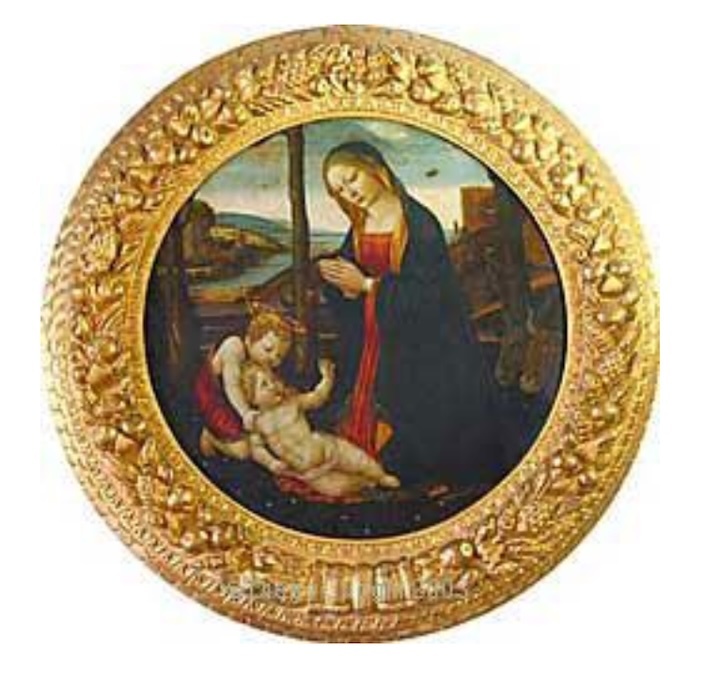
“Meanwhile the average man had become progressively less able to recognize the subjects or
understand the meaning of the works of art of the past. Fewer people had read the classics of
Greek and Roman literature, and relatively few people read the Bible with the same diligence that
their parents had done. It comes as a shock to an elderly man to find how many biblical references
have become completely incomprehensible to the present generation.”
Kenneth Clark
( introduction to"Dictionary of subjects and symbols in Art" by James Hall)
Inzwischen war der Durchschnittsmensch immer weniger in der Lage, die Motive zu erkennen oder die Bedeutung der Kunstwerke der Vergangenheit zu verstehen. Immer weniger Menschen hatten die Klassiker der griechischen und römischen Literatur gelesen, und nur wenige lasen die Bibel mit der gleichen Sorgfalt wie ihre Eltern. Für einen älteren Mann ist es ein Schock, festzustellen, wie viele biblische Bezüge für die heutige Generation völlig unverständlich geworden sind.
Kenneth Clark
(Einleitung zu „Dictionary of Subjects and Symbols in Art“ von James Hall)
+
As widely known, the acronym U.F.O. stands for “Unidentified Flying Object”.
Obviously once a Flying Object is identified, it cannot be considered a UFO anymore. These pages deal with a series of Flying Objects which, as some people say, appear into ancient works of art. As a matter of fact many books, and above all many web sites dealing with paleo-astronautic or clipeology, present various works of art as an evidence of UFO sightings in the past. Unfortunately, once seriously considered, these same works of art prove to be much more related to art itself than to any UFO concern.
The following web sites are just few of the many that deal with the subject:
Wie allgemein bekannt, steht das Akronym UFO für „Unidentifiziertes Flugobjekt“.
Sobald ein Flugobjekt identifiziert ist, kann es natürlich nicht mehr als UFO betrachtet werden. Diese Seiten befassen sich mit einer Reihe von Flugobjekten, die, wie manche behaupten, in antiken Kunstwerken auftauchen. Tatsächlich präsentieren viele Bücher und vor allem viele Webseiten, die sich mit Paläo-Astronautik oder Clipeologie beschäftigen, verschiedene Kunstwerke als Beweis für UFO-Sichtungen in der Vergangenheit. Leider erweisen sich diese Kunstwerke bei genauerer Betrachtung als viel mehr mit Kunst selbst als mit UFO-Sichtungen verbunden.
+
CRUCIFIXION
( Visoki Decani Monastery, Kosovo)
KREUZIGUNG
(Kloster Visoki Decani, Kosovo)
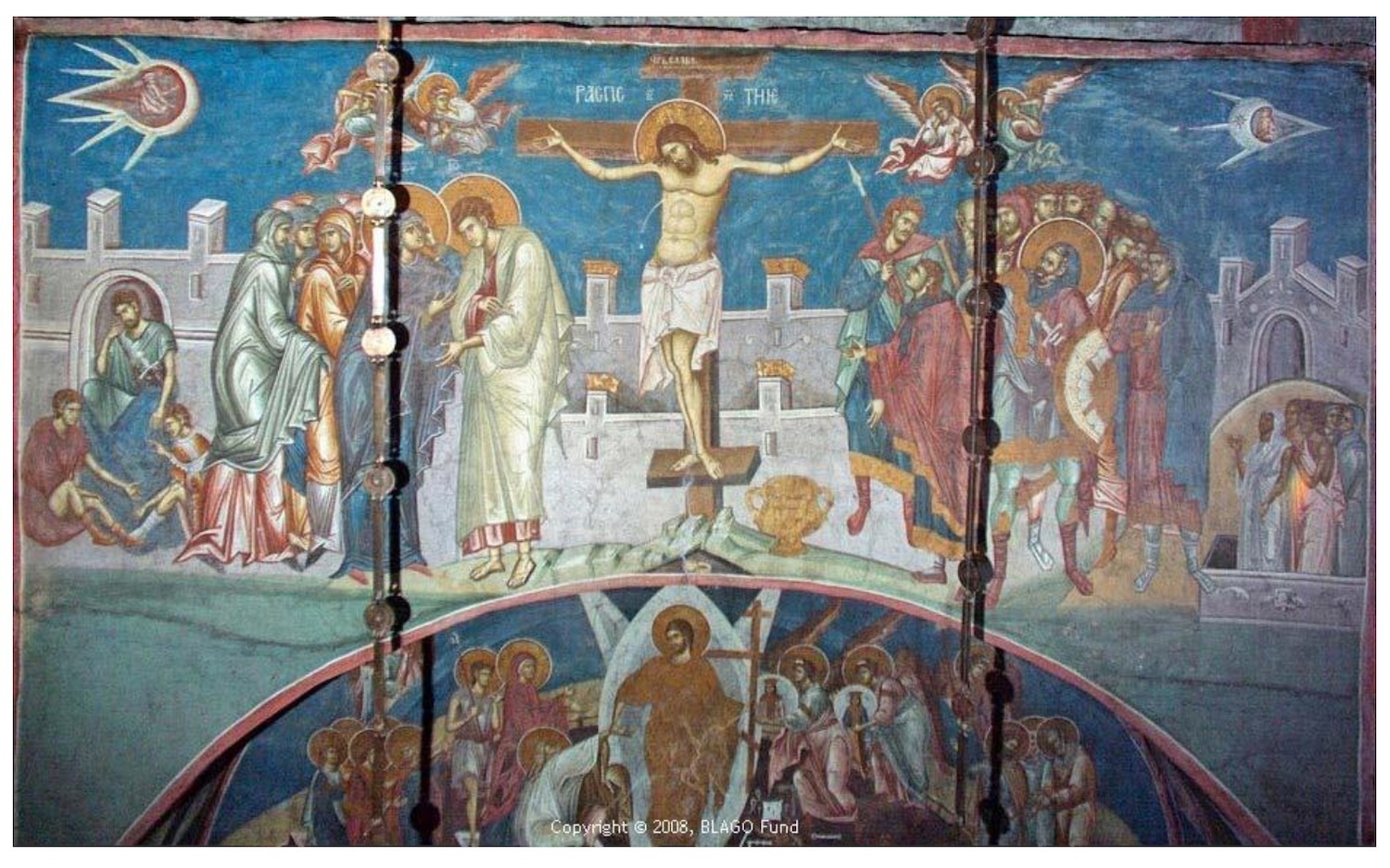
(photos courtesy of BLAGO Fund Archives, from http://www.srpskoblago.org)
This 14th century Crucifixion, a fresco in the Visoki Decani Monastery in Kosovo, is, like the previous one, considered a UFO-painting. The two strange objects at the sides of the cross are considered to be the UFOs:
Dieses Kreuzigungsfresko aus dem 14. Jahrhundert im Kloster Visoki Decani im Kosovo gilt wie das vorherige als UFO-Gemälde. Die beiden seltsamen Objekte an den Seiten des Kreuzes gelten als UFOs:
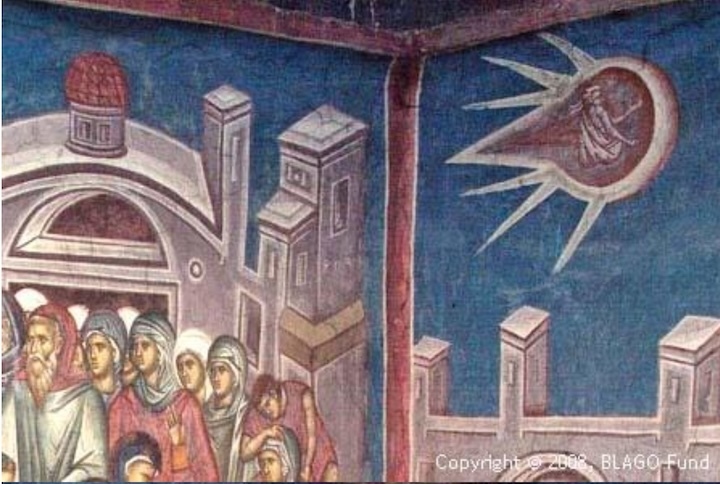
(photos courtesy of BLAGO Fund Archives, fromhttp://www.srpskoblago.org)
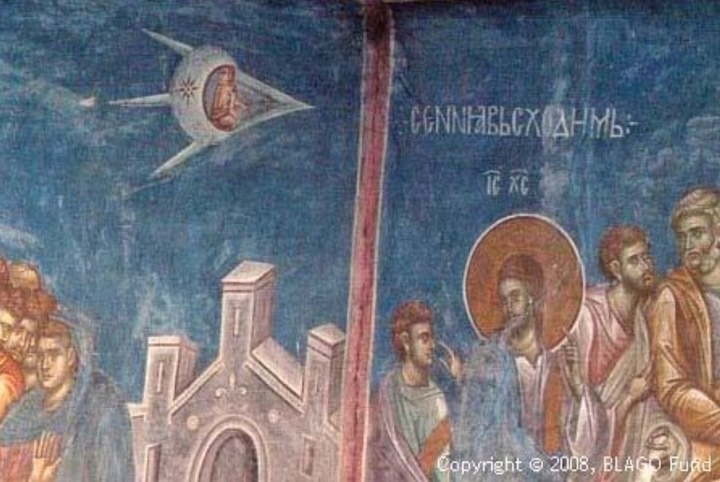
(photos courtesy of BLAGO Fund Archives, fromhttp://www.srpskoblago.org)
This is one of the oldest documented UFO-in-art cases because the first articles about it were published in the sixties, in the French magazine “Spoutnik.” This fresco was “discovered” by Alexandar Paunovitch, a student at the Academy of Arts of Yugoslavie in 1964. After this early publicity, the pictures were featured in many books about UFOs. On many web pages we read that the two objects in the sky are, without any doubt, “spaceships with crew.”
But this Crucifixion also follows the common iconographic model of the Middle Ages. The “Deposition from the Cross” of Benedetto Antelami, in the Dome of Parma in particular resembles the Crucifixion of Visoki Decani:.
Dies ist einer der ältesten dokumentierten Fälle von UFOs in der Kunst, da die ersten Artikel darüber bereits in den 1960er Jahren in der französischen Zeitschrift „Spoutnik“ erschienen. Das Fresko wurde 1964 von Alexander Paunovitch, einem Studenten der jugoslawischen Kunstakademie, „entdeckt“. Nach dieser frühen Publizität erschienen die Bilder in zahlreichen Büchern über UFOs. Auf vielen Webseiten ist zu lesen, dass es sich bei den beiden Objekten am Himmel zweifelsohne um „bemannte Raumschiffe“ handelt.
Doch auch diese Kreuzigung folgt dem gängigen ikonografischen Modell des Mittelalters. Insbesondere die Kreuzabnahme von Benedetto Antelami im Dom zu Parma ähnelt der Kreuzigung von Visoki Decani.
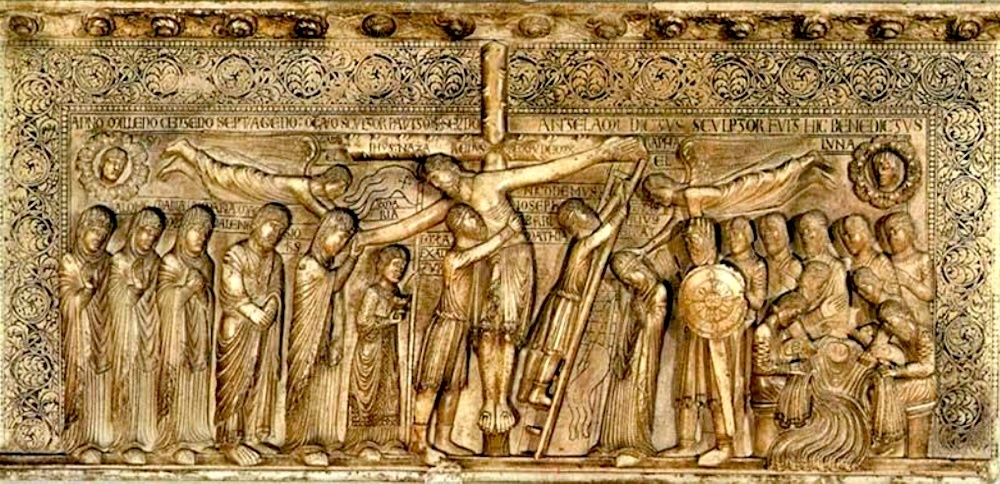
On the edges of the composition, in the same position as in the fresco of Visoki Decani, the Sun and the Moon are represented as human witnesses to the Crucifixion just as they are in the previous painting. In both art works the figures who represent the Sun and the Moon look towards the Cross that is located in the center of the composition.
The Sun and Moon, represented as human figures, are visible in many Byzantine- Orthodox sacred paintings, therefore as we have seen in the previous understood one it, dedicated to the Crucifixion of Mtskheta. Below a particular of an ancient Gospel (Treasure of Saint Clement, sec. XIV) and a modern byzantine fresco:
An den Rändern der Komposition, an derselben Stelle wie im Fresko von Visoki Decani, sind Sonne und Mond als menschliche Zeugen der Kreuzigung dargestellt, genau wie im vorherigen Gemälde. In beiden Kunstwerken blicken die Figuren, die Sonne und Mond darstellen, auf das Kreuz in der Mitte der Komposition.
Sonne und Mond, als menschliche Figuren dargestellt, sind in vielen byzantinisch-orthodoxen Sakralgemälden zu sehen, daher haben wir im vorherigen Gemälde, das der Kreuzigung von Mzcheta gewidmet ist, auch eines verstanden. Nachfolgend ein Ausschnitt aus einem antiken Evangelium (Schatz des Heiligen Clemens, Abschnitt XIV) und einem modernen byzantinischen Fresko:
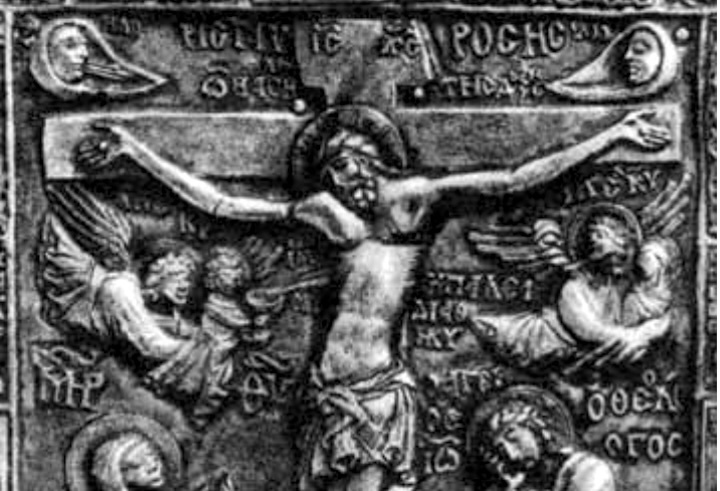
+
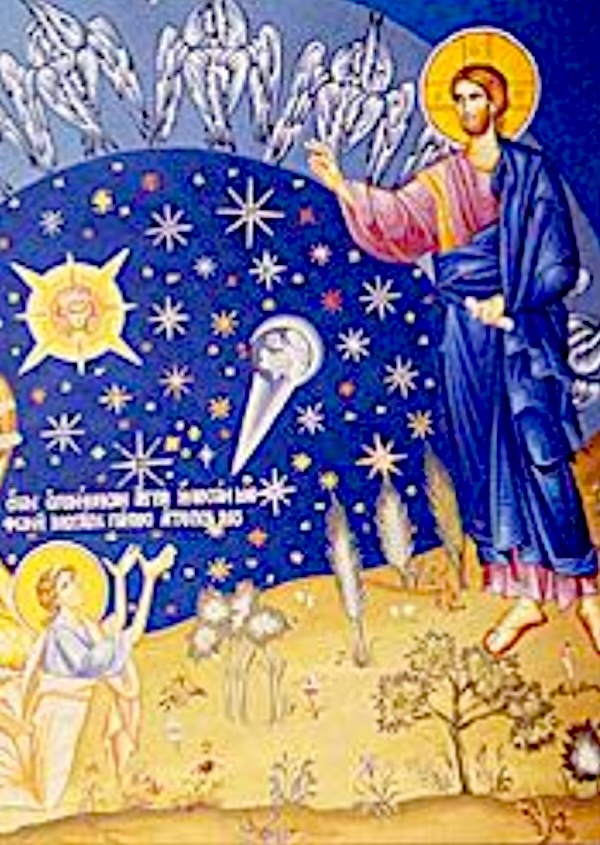
James Hall, author of the "Dictionary of Subjects & Symbols In Art" writes:
“ The sun and moon, one on each side of the cross, are a regular feature of Medieval crucifixions. They survived into the early Renaissance but are seldom seen after the 15th century. Their origin is very ancient. It was the custom to
represent the sun and moon in images of the pagan sun gods of Persia and Greece, a practice that was carried over into Roman times on coins depicting the emperors.”
(...) The sun is[sometimes represented as simply a man’s bust with a radiant halo, the moon as a woman’s with the crescent of Diana. Later they are reduced to two plain disks, the moon having a crescent within the circle, may be borne by angels. The sun appears on Christ's right, the moon on his left.”
Two ivories from the Museé de Cluny, Paris, the Sun and the Moon are on sides of the cross:
James Hall, Autor des „Dictionary of Subjects & Symbols In Art“, schreibt:
„Sonne und Mond, jeweils eine auf jeder Seite des Kreuzes, sind ein fester Bestandteil mittelalterlicher Kreuzigungen. Sie überlebten bis in die frühe Renaissance, sind aber nach dem 15. Jahrhundert nur noch selten zu sehen. Ihr Ursprung ist sehr alt. Es war Brauch, Sonne und Mond in Bildern der heidnischen Sonnengötter Persiens und Griechenlands darzustellen, eine Praxis, die bis in die Römerzeit auf Münzen mit Kaiserdarstellungen überging.“
(...) Die Sonne wird manchmal einfach als Männerbüste mit strahlendem Heiligenschein dargestellt, der Mond als Frauenbüste mit der Mondsichel der Diana. Später werden sie auf zwei einfache Scheiben reduziert, wobei der Mond eine Sichel innerhalb des Kreises hat und von Engeln getragen werden kann. Die Sonne erscheint rechts von Christus, der Mond links von ihm.“
Zwei Elfenbeinfiguren aus dem Museé de Cluny, Paris, zeigen Sonne und Mond an den Seiten des Kreuzes:
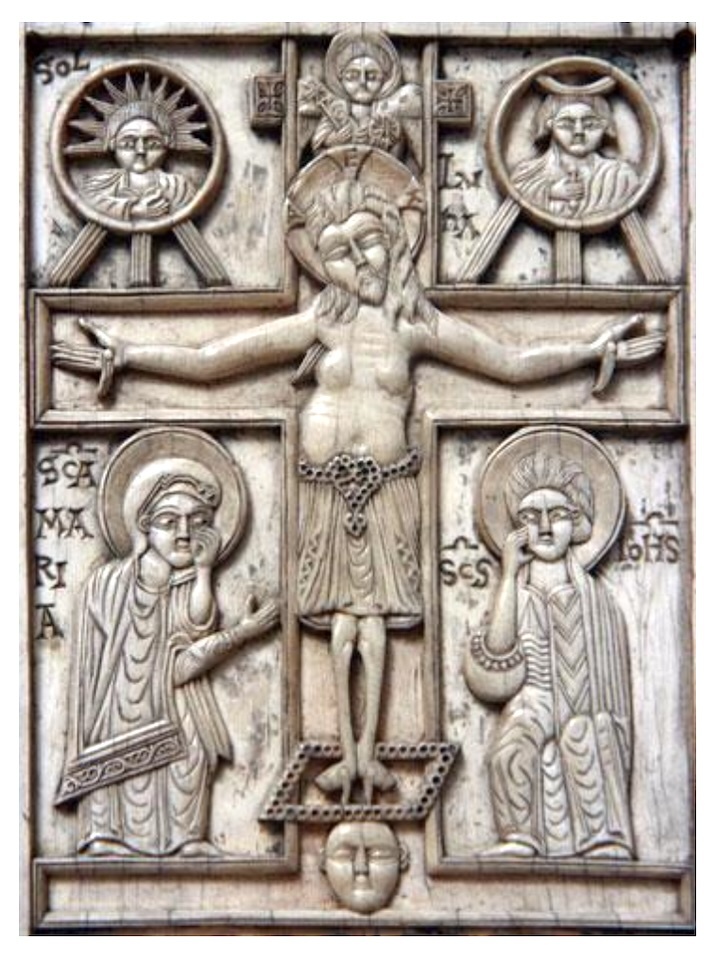
+

Often, the Sun and the Moon were represented as human characters driving wagons drawn by horses and by oxen, as in this ivory bas-relief , the binding of the "Book of Pericopi of Henry II " from XI century (München, Bayerische
Staatsbibliothek):
Sonne und Mond wurden oft als menschliche Figuren dargestellt, die von Pferden und Ochsen gezogene Wagen lenkten, wie in diesem Elfenbeinflachrelief, dem Einband des „Perikopenbuchs Heinrichs II.“ aus dem 11. Jahrhundert (München, Bayerische Staatsbibliothek):
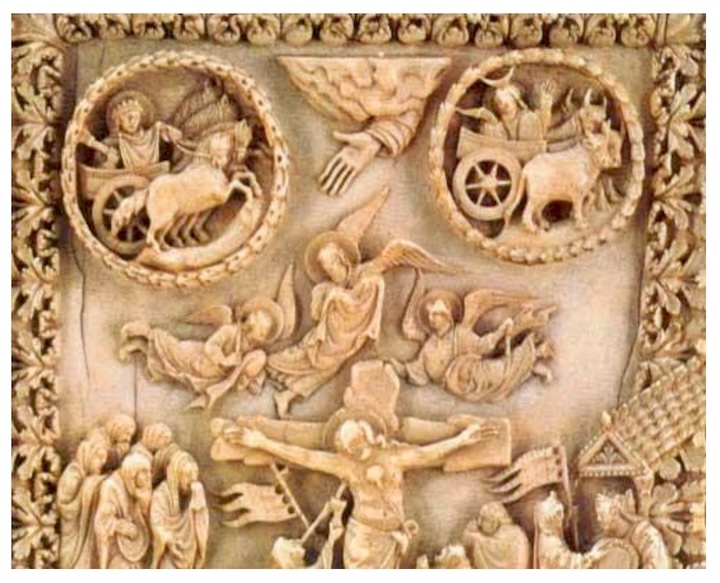
A sculpture by Benedetto Antelami in the Dome of Parma, with the story of Barlaam and Josafat, where the Sun and the Moon appear to be "doubled" in the figures of the fighting Day and Night.:
Eine Skulptur von Benedetto Antelami im Dom von Parma mit der Geschichte von Barlaam und Josafat, in der Sonne und Mond in den Figuren des kämpfenden Tages und der Nacht „verdoppelt“ erscheinen:
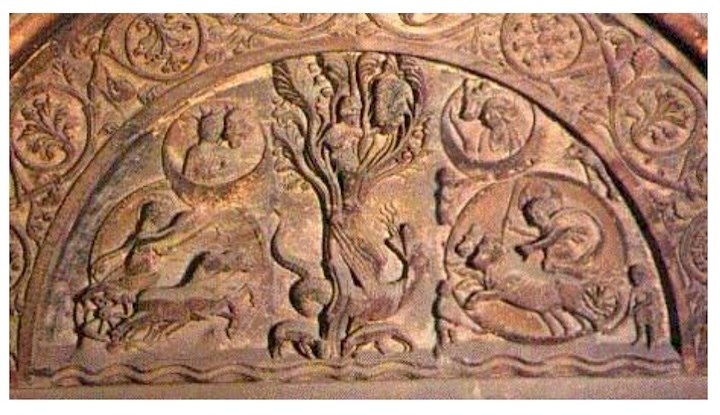
In the same Decani Monastery, in a lower level vault, there are other depictions of the "humanized" Sun and Moon:
Im selben Decani-Kloster gibt es in einem Gewölbe auf einer niedrigeren Ebene weitere Darstellungen der „vermenschlichten“ Sonne und des Mondes:
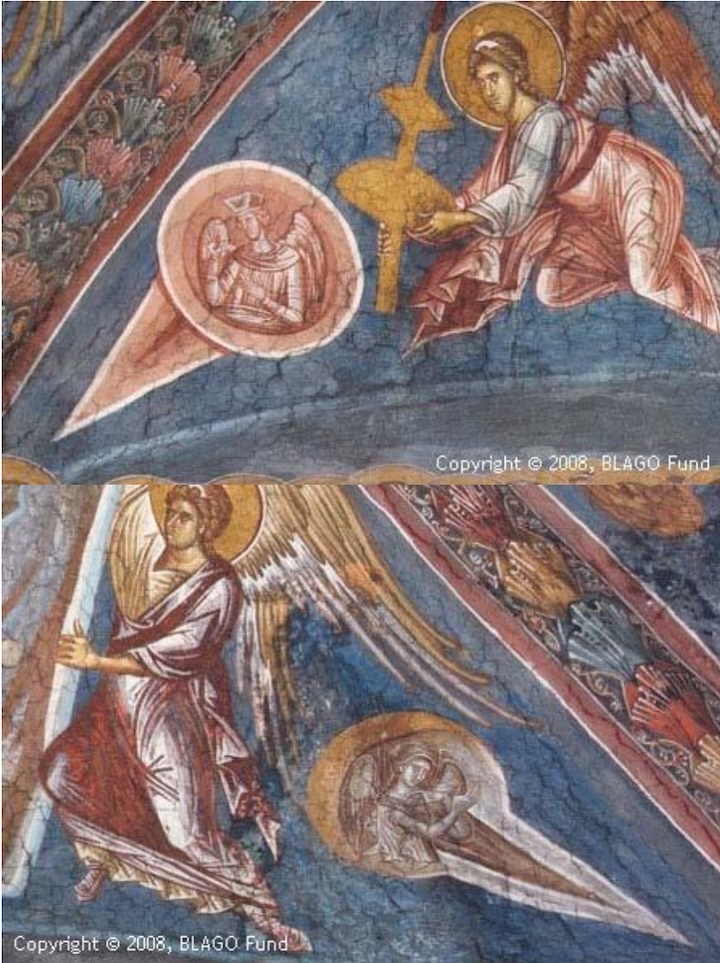
Conclusions:
In the Visoki Decani Crucifixion fresco there are no UFOs. The two objects near the cross are anthropomorphic symbols of the Sun and the Moon, represented in much the same way as they are in many other Byzantine Crucifixions.
Schlussfolgerungen:
Im Kreuzigungsfresko von Visoki Decani sind keine UFOs zu sehen. Die beiden Objekte in der Nähe des Kreuzes sind anthropomorphe Symbole für Sonne und Mond, die ähnlich wie in vielen anderen byzantinischen Kreuzigungsbildern dargestellt werden.
